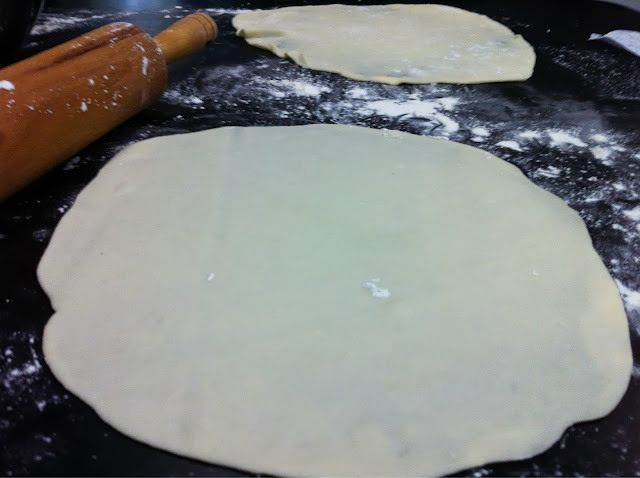Saj bread is a Middle Eastern bread rolled and stretched as thin as paper and cooked over a burning hot iron. I realized how much I missed my thin Lebanese bread when I moved to China. I did find a version of pita bread at a large chain wholesale store that sold some import products and it really is not bad. It is a bit thick for my taste and can only be used to make pita pocket sandwiches. But what about shawarma, falafel, zaatar and zeit, and labne sandwiches rolled in thin flat bread? Not possible, until I went on a quest to make it myself!
I've seen flat bread made by hand in the countryside of Lebanon, usually outside, hand stretched to an amazing thinness. Where I lived previously in Michigan, large Middle Eastern bakeries provided a multitude of varieties of breads, saj bread was a favorite. I began with my basic bread dough recipe, rolled out the dough and laid it in a large flat pan. That experiment worked but it was difficult to transfer the dough without having it fold onto itself.
From what I remembered, the cooking tool used traditionally is dome shaped. Hmmm... what could I use that is dome shaped and can withstand a high gas flame? Thats it! One cooking tool that is plentiful in China- a wok. An iron wok turned upside down makes a perfect dome shape! I found the perfect wok and ran home to experiment. And to my delight (and extreme enjoyment from household members) the result was a stack of soft, pliable and exceptionally thin sheets of saj bread!
Ingredients:
3 cups all purpose flour
1 cup whole wheat flour
1 teaspoon salt
1 1/2 tablespoons yeast
1 tablespoon sugar
1/4 cup warm water
1/2 cup canola oil
3 cups warm water
Measure the yeast and sugar and mix in a small bowl with warm water. Set aside for 5 minutes to ferment. Meanwhile, place the flours and salt in bowl, mix lightly and create a well in the center. Pour the yeast mixture and the oil in the center of the well, add the milk. I like to mix the dough by hand: roll up your sleeves and get in there! Add as much of the water as needed to create a soft dough. Keep kneading until well mixed and the dough becomes less sticky and hold together.
Transfer the ball of dough to a large bowl that has been lightly brushed with oil. Cover with plastic wrap and a towel and set in a warm place to rise for about an hour.
Now the dough is ready to be worked with. Punch it down and knead well. Flour your working surface and knead the dough until it no longer sticks to the countertop and becomes firm. At this point you can place in the fridge for over 24 hours until you are ready to use it, or work with the dough right away.
Begin by inverting the wok over the stove top over a low to medium flame and let it heat up. Section the dough into baseball sized balls and with a well floured surface and rolling pin, roll it out until it gets very thin. Keep moving the dough in a circle while rolling and flouring your surface. You're not done yet, lift the dough and stretch at the corners until it becomes paper thin! Then drop onto the hot dome.
Let the bread cool, then you can use as a wrap and fill with any filling you please! I like to brush it with a mixture of olive oil and zaatar, which is a mix of dried oregano, sumac and sesame seeds. Also, spread with labne- a thick yogurt cheese and olives is light and satisfying.


















